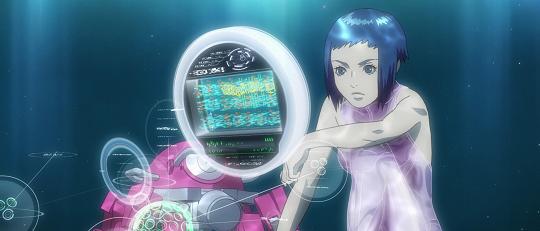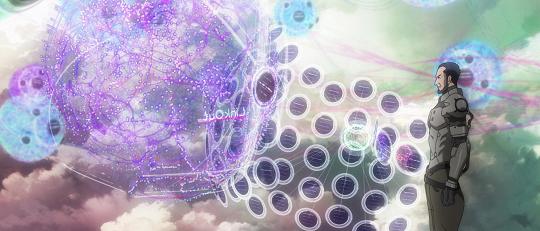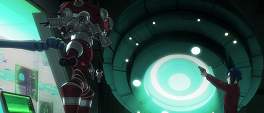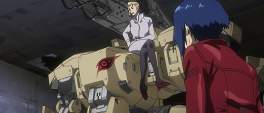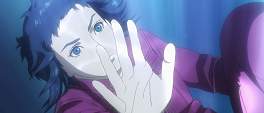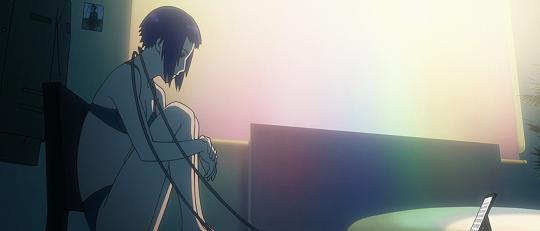It’s not even worth reading this post if you’re expecting the kind of excoriation that many have lumped on the latest Ghost in the Shell instalments. I’d already set out my stall with Arise when promotional material came out for it and my affinity for Standalone Complex is sparsely documented but well understood. Fifty percent of the expected run-time of Arise is now done with both Ghost Pain and Ghost Whispers out on home video release, it’s interesting to see what direction the series of OVAs has taken over and above the previous powerhouse of Standalone Complex and the two Mamoru Oshii directed movies.
For one this is definitely a divergence from the established lore for all of the characters involved, most of all Kusanagi who was no longer involved in an accident when a toddler forcing her to get one of the first fully prosthetic bodies. Similarly her presence during WW4 where she met both Ishikawa and Batou is in question, yet her position in the military remains. Aramaki is no longer greying and quite as world weary and the Tachicomas that became the Uchicomas are now the Logicomas - same idea different skin.
That’s really the methodology for the series so far at least: it’s a different take on the near-future espionage and state security framework that, to a degree, all of the Ghost in the Shell incarnations have adhered to. The layering of bureaucracy and machinations of governments and individuals in a world that is highly networked and ruthlessly mechanised, and ultimately facing new and increasing challenges because of it. Unlike a lot of science fiction and especially so with the persistently waning cyberpunk genre, the focus of Ghost in the Shell has only ever been obliquely about the technology, more presciently it is about the people and organisations who would subvert and consume that technology.
The first episode of Arise, Ghost Pain, is no different and sees an arms dealer dead and a deceased military official’s conduct under scrutiny. It’s a complicated plot that teases and twists until the very end as each piece falls into place. It also sees a younger and more inexperienced Kusanagi without her usual squad for support facing her once brothers in arms. It’s the most fundamental change to the formula as it means she is no longer the aloof and lethal individual she is usually portrayed as and is very much “in the thick of it” rather than skating tactically around situations.
The switch to Maaya Sakamoto for the Major’s voice isn’t as jarring as the change may suggest, Maaya has proven she pull of characters like Shiki from Kara no Kyoukai without sounding like Hitomi from Escaflowne putting on a gruff voice. More tellingly though is a switch away from the bombastic sexpot that Kusanagi’s attire has suggested in the past; clad in military uniforms rather than cleavage bearing one-pieces, this is top-to-toe a different Kusanagi than we have seen before.
Changes don’t happen across the board though and Aramaki is still the slightly exasperated but politically savvy architect - here though he’s just biding his time for a team to form. The Logicoma is the most egregious addition given that the Tachicomas from before made similarly miraculous rebirths in both 2nd GIG and Solid State Society. As artificial intelligences with a philosophical bent they gave the TV series a lot more scope than they would have with their exclusion - metaphysical questioning wrapped up as light relief. The Logicoma’s use in Arise thus far has been as a weapon storage and object of interest for the second entry, Ghost Whispers.
Indeed, the second hour-long OVA is tonally very different to the first, relying far more heavily on action to keep things moving. Certainly the triumvirate of driving / shooting / hacking is wonderful to have back but the pornographically slow-motion tussles stick out like a sore thumb. More critically is the information dump that follows the shoot outs leading to an unsatisfying plethora of information that had been so meticulously meted out in Ghost Pain. Were that its only flaw though then it would still be easy to heap praise upon it, its failing though is in adding very little to either the world, the characters or the ongoing narrative.
Batou is given the lion’s share of the development despite his relative lack of presence, the sniper Saito though undergoes an almost complete transformation from his mysterious and calculating persona in Standalone Complex: now just a flippant mercenary, switching sides when he feels the winds changing. Story elements that will no doubt play a larger part in the instalments to come are laid down with a rogue AI and the formation of Kusanagi’s team, however it feels like we’ve seen all of this before. We’ve seen Kusanagi hide behind concrete pillars as a walking tank takes aim, we’ve had AI’s go out of control. The fine line between homage and laziness is a fine one and Ghost Whispers treads too far into the latter.
Perhaps though, that is the curse of expectation lying in wait and ready to pounce on any perceived weakness. Ghost Pain brooked none of that by playing to its own rules, embracing the history of the franchise without ever directly referencing it. It certainly played to Masamune Shirow’s more overt fetishes with the needlessly young and feminine humanoid land mines, but by setting alone this feels further from his original manga than even Mamoru Oshii’s divisive second film. Tow Ubukata at the writing desk obviously brings a differing vision, with his work on Mardock Scramble either a selling point or a cautious black mark depending on your view.
With probably another full year to go before Arise is completed, only time will tell whether the missteps of the second feature are a portent of things to come. Regardless of vocal opinion, Ghost Pain is a stunning follow up to a series I and many others hold very dear and ticks all of the boxes for a smart, uncompromising and vivid look at a near future world. Ghost Whispers is thrilling and vicious but by comparison is found lacking, this still puts it far in advance of almost anything else, animated or no. Arise then is a Ghost in the Shell series for a different time; when Standalone Complex was airing social media was but an idea and high-definition was in an even earlier form than 4K is today. Its aesthetics may not be to everyone’s tastes, but it is still the same cerebral and bewitching proposition in 2013/14 as it was in 1995 and 2002.

